Museums, Theaters, Architecture, Dong Hoi
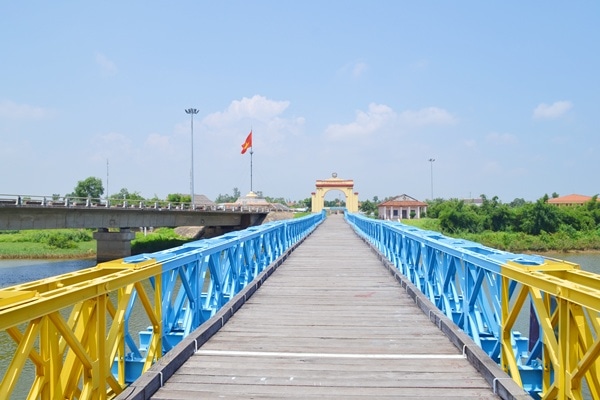
Removed from Unnamed collection
Hien Luong Bridge 
The Hien Luong Bridge - a bridge across the Ben Hai river, which was part of the border between North and South Vietnam from 1954 until the reunification in 1976. Today, the bridge is still there and seen as an important national monument to the reunification of Vietnam. Near the bridge is also a museum, propaganda war remnants and two memorials.
The old narrow bridge itself is a simple steel structure built by the French. The bridge is now just a pedestrian bridge. A modern bridge, which is next, takes all the traffic across the river on its behalf. You can walk across the old bridge over the entire length (165 meters).
The old bridge was during the war with the Americans, part of the DMZ. The acronym DMZ stands for Demilitarized zone (literally a demilitarized area). It is a buffer zone between two countries where tensions exist. In this case, it was the North and South Vietnam. https://www.vietnamsite.nl/hienluongeng.htm
Map
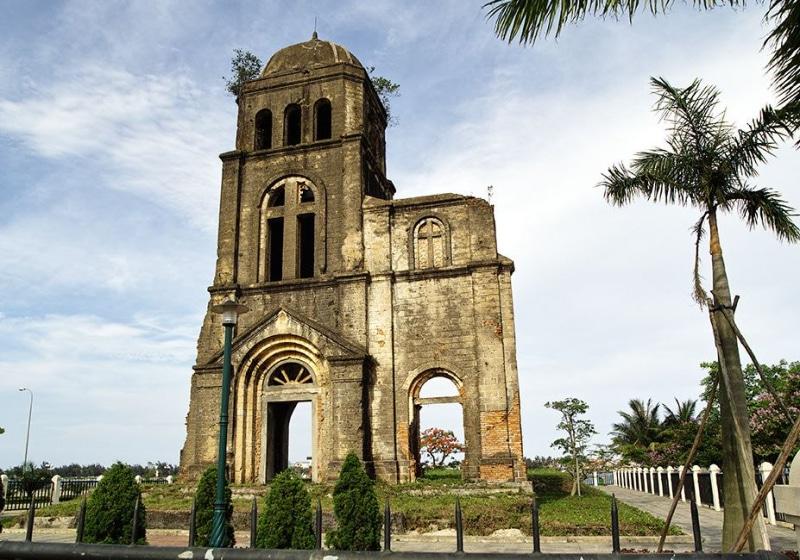
Removed from Unnamed collection
Tam Toa Church 
Tam Toa Church is a Catholic church located on Nguyen Du Street, Dong My Ward, Dong Hoi City, Quang Binh Province. The church was built in 1886.
Han Mac Tu was baptized here in 1912 with the Christian name Nguyen Trong Tri Franois. In the eight years from 1964 to 1972, the US air bombardment of North Vietnam. Dong Hoi was flattened, Tam Toa church was bombed only the bell tower remained. After the Geneva Agreement in 1954, the whole Tam Tran migrated to the South. Since then the church has been abandoned. During the Vietnam War, Tam Toa Church was bombed 48 times by the United States Air Force. On February 11, 1965, the church was hit by a bomb, leaving only the bell tower with bullet holes.
Dong Hoi town was razed by US bombs and the church bell tower became a war relic. On February 26, 1997, the People's Committee of Quang Binh province issued Decision No. 143 / QD-UB, The court has become a war crimes vestige and is historical-cultural vestiges of the province, which need to be strictly protected.
October 23, 2008, Quang Binh People's Committee and the Bishop of Doai was united and signed a memorandum saying: "The old Tam Toa Church is now evidence of war crimes. The two sides will maintain and embellish in order to protect and serve the traditional research and education for the young generation...
In the Quang Binh tour short or long, visitors more or less have the opportunity to visit many historical relics, evidence of war in this land. Tam Toa Church is the largest Catholic church in Quang Binh, also the largest and only church of Dong Hoi city, located in the heart of the city. https://originvietnam.com/destination/vietnam/quang-binh/tam-toa-church.html
Map

Removed from Unnamed collection
Vinh Moc Tunnels 
In Vinh Moc - you'll find a very impressive temple complex. They are the remains of a North Vietnamese fishing village, where the people have built a tunnel complex to protect themselves against the American bombing. Literally, the village went underground. It offered protection to more than 90 families. The tunnel complex has three levels. The majority of the tunnels is open to visitors and is kept in their original state (with the exception of the recent addition of electric lighting).
The tunnels were used not only for civilian purposes (the distinction between civilians and Vietcong is a dim area), but were also used to transport weapons and other equipment. These were brought to Con Co Island, a base off the North Vietnamese coast near Vinh Moc in the South China Sea.
The tour usually starts at the museum, which is above the ground. There are objects and photographs on displays. There is also a watch, which is a gift from the GDR.
Then begins the real visit to the tunnels. The tunnels are situated at a depth of 11 to 20 meters. You'll pass the "family quarters" - really just niches on the side of the main tunnel, with barely enough room for three people and zero privacy. They also show you larger dwellings, which were used for meetings, storage, and as a hospital. Nowadays, there are life-sized puppets, to make it clear for the tourists.
Suddenly you stand again in daylight, right by the sea, just above a beach. This output is well camouflaged. This output was at night to receive weapons and other supplies, which were sent via Con Co Island. Then you go back in and finally you'll get out at one of the ground-level exits.
During the approximately four years they lived under the ground, there were 17 babies born in the "tunnel hospital." In principle, these babies would only see the light when the war was over. https://www.vietnamsite.nl/vinhmoceng.htm
Map

Removed from Unnamed collection
De Dong Hoi Citadel 
De Dong Hoi Citadel - is located in the centre of town. It is a complex of high fences and towers. A citadel is a fortress that dominates the city. This fort had to defend the king and the capital from the Nguyen dynasty defend since 1630. The citadel is 1,500 meters away from the Nhat Le beach and it is adjacent to the Nhat Le River on the east side and the forest on the west side. Only two gates and a moat remain of the citadel. You can climb up in the gates, but inside you will find syringes and burnt debris.
Dong Hoi citadel has played an important position in many periods of history. In 1885 the French army attacked the citadel, but the people and soldiers of Dong Ha defended the citadel well and won the battle triumphant, that's why the French had to withdraw. During the war between Vietnam and France in 1945-1954, the locals also made several attacks on the citadel. Nowadays there is no more war in Vietnam, but the beautiful Dong Hoi citadel is still alive as an honourable symbol of the brave country. It draws many visitors from all places in Vietnam and around the world. https://www.vietnamsite.nl/donghoicitadeleng.htm
Map
Explore more places related to this search:
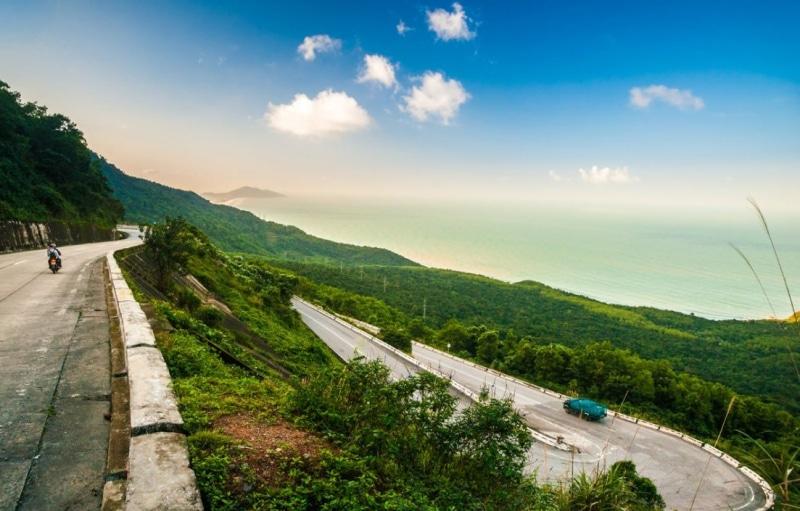
Removed from Unnamed collection
Hai Van Pass 
Hai Van Pass or Sea Clouds Pass offers an impressive landscape of verdant mountains and clear blue skies, overlooking Da Nang City, Tien Sa Port, Son Tra Peninsula, and South China Sea. Crossing over a spur of Truong Son mountain range between Thua Thien-Hue Province and Da Nang City, it stands at 500m above sea level, making it the highest pass in Vietnam.
The 25 kilometre-long mountain pass is popular amongst thrill-seeking motorcyclists due to its winding roads, sudden curves and blind corners, while its lookout point offers gorgeous views of Da Nang Bay.
The pass also hosts the ancient Tran Dynasty’s Hai Van Gate, Hai Van Tunnel (the longest in ASEAN), wartime gun towers, and a decrepit French-built fort that was later used as a bunker by South Vietnamese and US armies during the Vietnam War. Prior to the construction of the Hai Van Tunnel, the mountain pass was notorious for its fair share of fatal accidents – look out for small altars set along the roadside that are dedicated to perished victims. http://www.vietnam-guide.com/da-nang/attractions/hai-van-pass.htm
Map
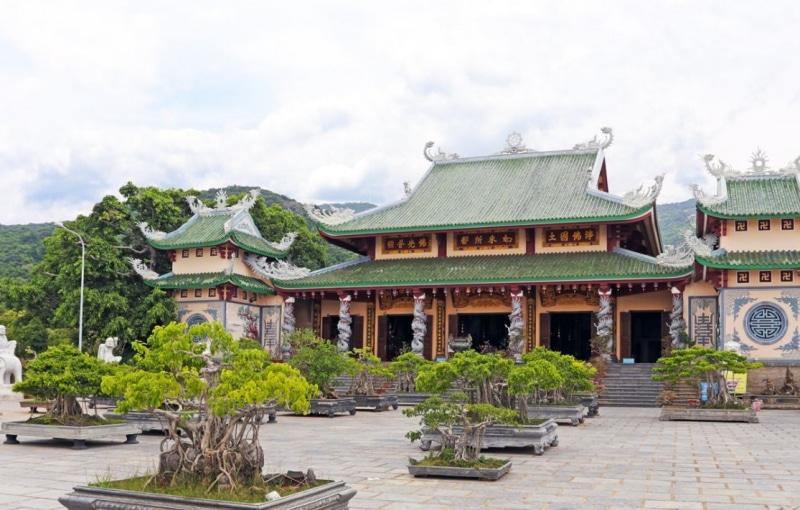
Removed from Unnamed collection
Phap Lam Pagoda 
Phap Lam Pagoda is a two-storey temple in Da Nang City Centre, featuring towering trees, manicured gardens, and intricate Buddhist sculptures. Formerly known as Tinh Hoi Pagoda (until renamed as Phap Lam Pagoda), it was built in 1934 along Ong Ich Khiem Street, where Con Market is just a five-minute stroll away.
Despite its location within the bustling Da Nang city centre, the atmosphere here is very serene and peaceful. You can see locals praying in the morning or getting their fortunes told while the resident monks go about their daily lives. As with any Buddhist temple in Vietnam, Phap Lam Pagoda gets packed with devotees during annual festivities such as Tet and Lunar New Year.
The top floor of the pagoda is a presbytery that features intricately carved pillars, handwritten Buddhist Pali incantation, and a golden statue of Buddha while the ground floor hosts an amphitheatre that can accommodate up to 1,000 people. The courtyard of the pagoda houses a 1.1-metre-high seated Buddha statue as well as brass statues of the Goddess of Mercy (Avalokitecvara) and Dai The Chi Bodhisattva. Entrance to Phap Lam Pagoda is free of charge, but donations are welcomed. http://www.vietnam-guide.com/da-nang/attractions/phap-lam-pagoda.htm
Map
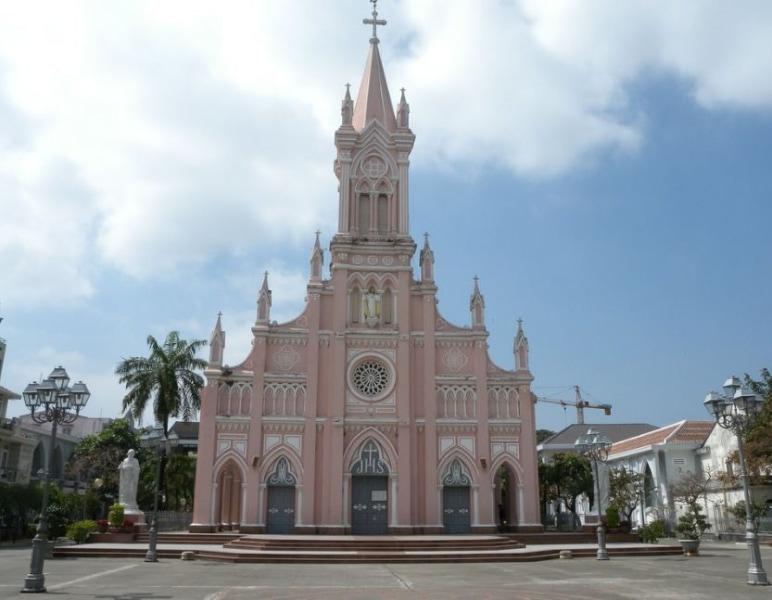
Removed from Unnamed collection
Da Nang Cathedral 
Da Nang Cathedral was built by French priest Louis Vallet in 1923, with a pink-painted edifice that earns its reputation as one of the most unique catholic churches in Vietnam. Standing at 70 metres, it’s also known as Con Ga Church (Rooster Church) due to the imposing bell tower that’s topped with a rooster weathercock.
The church features a simple interior design of engraved motifs, rhombic-shaped arches, medieval-style stained glass windows of various saints, and statues depicting events from the Holy Bible. There’s also a grotto of the Blessed Virgin Mary set behind Da Nang Cathedral, which is a replica of the Lourdes Grotto in France.
As the only church in Da Nang, it serves the local Catholic community of over 4000 parishioners to this very day. Services are held in different languages daily, with English-spoken sermons on Sundays at 9:00. If you’re looking to visit this church for Mass, make sure to head there early due to limited seats. Entrance to Da Nang Cathedral is also free of charge. http://www.vietnam-guide.com/da-nang/attractions/da-nang-cathedral.htm
Map
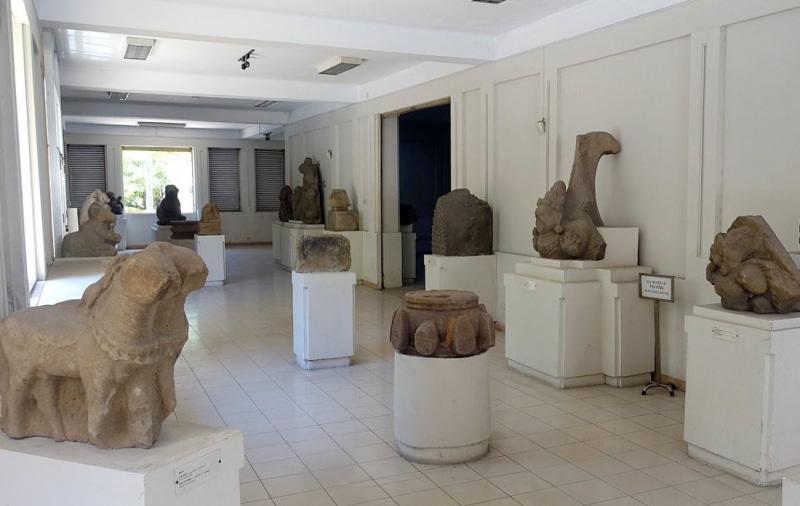
Removed from Unnamed collection
Da Nang Museum of Cham Sculpture 
With their roots dating back as far as 192 AD, Vietnam's indigenous Cham people lived an Indian way of life in both culture and language. The Cham Museum in Danang is dedicated to this period and the Champa existence which began predominantly in the coastal areas of Vietnam. Housing the largest exhibition of Cham sculpture in the world, the museum displays almost 300 terracotta and stone works of art ranging from the 7th to the 15th centuries.
Many of the exhibits are considered masterpieces of their field showcased according to the region in which they were found with a total of ten separate interior exhibition rooms. All of the sculptures on display fall into one of the following sections – icon, pedestal, pediment, or fragment, with the area in which they were found determining where they are exhibited.
When you've finished browsing the internal creations, step outside to appreciate the building itself carefully crafted with objects of worship including idols and holy animals surrounded by flowers, leaves and turrets all symbols of Hinduism. http://www.vietnam-guide.com/da-nang/cham-museum.htm
Map

Removed from Unnamed collection
Dragon Bridge 
Dragon Bridge in Da Nang is the longest bridge in Vietnam, offering a dazzling display of lights, fire, and water that no first-time visitor to Da Nang should miss out on. Measuring at 666 metres in length, it is located in Da Nang City and constructed in the shape of a golden dragon.
The six-lane bridge crosses the Han River, serving as direct routes to My Khe Beach and Non Nuoc Beach as well as a popular spot amongst travelling photographers. Dragon Bridge was officially opened in 2013 after a two-year-long construction, commemorating the 38th anniversary of Da Nang City’s liberation. According to local beliefs, which date back to the Ly Dynasty, the dragon is a significant symbol of power, nobility and good fortune. http://www.vietnam-guide.com/da-nang/attractions/dragon-bridge.htm
Map
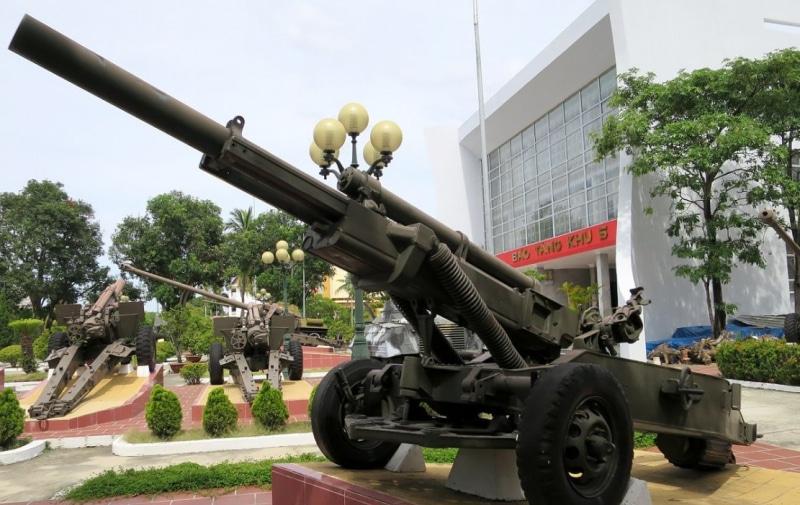
Removed from Unnamed collection
Fifth Military Division Museum 
The Fifth Military Division Museum of Da Nang was built in 1977, offering visitors a glimpse of Vietnam’s tumultuous past with extensive displays of war relics, news articles, and photographs taken by soldiers of the Fifth Military Division. The museum also commemorates Vietnam’s most beloved leader with a replica of Ho Chi Minh's residence and a separate Ho Chi Minh Museum.
Divided into four main sections, its outdoor display area houses authentic aircraft, military tanks, and weapons used during the French and American wars. Most of these exhibits are in pristine condition, with must-sees including the A-37 Dragonfly light-attack aircraft, Cessna O-1 Bird Dog observation aircraft, and the M48 Patton gun tank.
The museum’s indoor display area comprises 12 showrooms, displaying thousands of photographs and news articles on the Vietnamese military’s establishment, struggles, and victory. There are also numerous personal belongings and interesting backgrounds of prominent soldiers, including a pair of slippers that belonged to Phan Thi Mua. She was a female special task force member who detonated an American fuel depot in 1972 by smuggling dynamite powder in her slippers. http://www.vietnam-guide.com/da-nang/attractions/fifth-military-museum.htm
Map
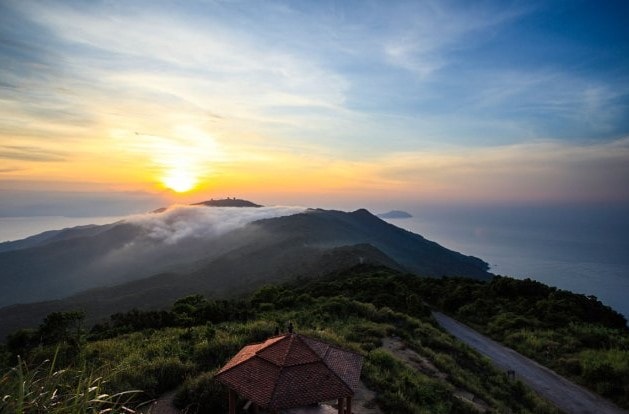
Removed from Unnamed collection
Son Tra (Monkey) Mountain 
Son Tra (Monkey) Mountain is a breath-taking national park in Da Nang that stands 693 metres above sea level. It’s a 35-minute drive from Da Nang, making it a popular retreat amongst locals and travellers looking to escape the heat and busy traffic of the city. Locally known as the Son Tra Peninsula, the verdant mountain is also surrounded by pristine beaches such as Bai Bac, Bai Nam, Bai But, and Tien Sa Beach.
Monkey Mountain was a prominent observation base during the American-Vietnam War, housing two radar domes that are now taken over by the Vietnamese military as well as a helicopter pad, which makes for a cool lookout point.
A prominent attraction in Da Nang is Linh Ung Pagoda, which is also set on Son Tra (Monkey) Mountain. The stunning pagoda was built during the 18th century and houses a 67 metre-tall white statue of the Goddess of Mercy, which is set atop a lotus-shaped platform. Hailed is the tallest statue of the deity in Southeast Asia, there are 17 levels within the structure and a total of 21 miniature Buddha sculptures. Entrance to Linh Ung Pagoda is free of charge, though it’s known to get crowded with pilgrimages during special occasions. http://www.vietnam-guide.com/da-nang/attractions/son-tra-mountain.htm
Map
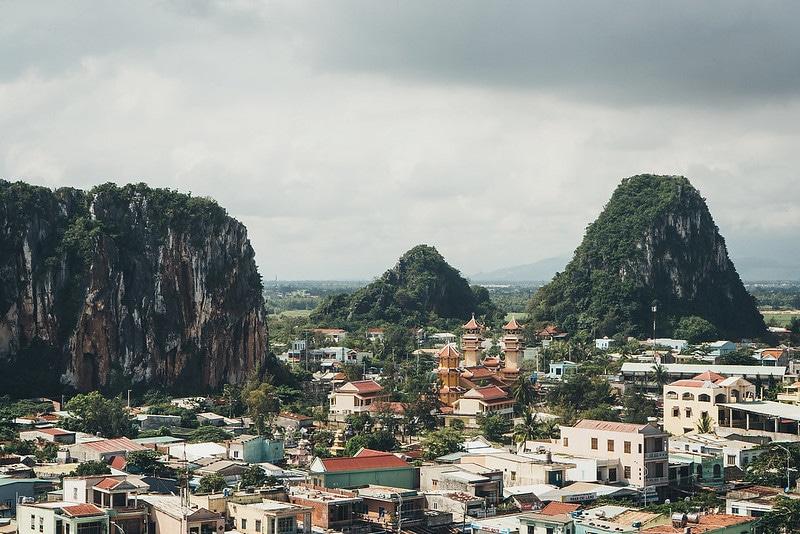
Removed from Unnamed collection
Marble Mountains 
The Marble Mountains are a cluster of five hills made from limestone and marble in Da Nang. It's also a well-known pilgrimage site with peaks, caves, tunnels and temples all just waiting to be discovered. Named after the elements metal, wood, water, fire and earth, Marble Mountains exist in a coastal area that is renowned for stone-cutting and sculpture about 9km south of Da Nang.
The caves within the mountains hold many secrets including bullet holes from when troops used to spy on the US soldiers relaxing on My Khe Beach below and buildings standing within the caves and grottoes. There are also Buddhist sanctuaries and places of worship dotted across the mountains which are a much-visited spiritual site. You can even see a special circular cave here. It leads to the summit, where you can enjoy spectacular panoramic views. http://www.vietnam-guide.com/da-nang/marble-mountain.htm
Map
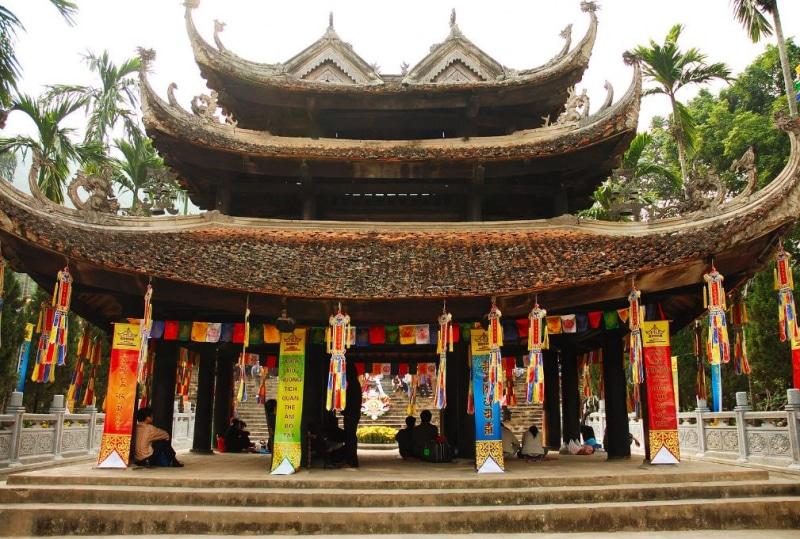
Removed from Unnamed collection
Perfume Pagoda 
The Perfume Pagoda, known locally as Chua Huong or ‘inner temple’, is at the centre of a very revered and sacred site featuring a maze of mainly Buddhist temples built into the limestone cliffs of Huong Tich. At the heart of this complex lies the Perfume Temple or Perfume Pagoda in the Huong Tich Cave.
It is believed that the first temple was built here in the 15th century, although legend declares that the site was actually discovered over 2,000 years ago by a Buddhist monk who was meditating nearby. The mountain foothills are an area of great natural and spiritual beauty filled with streams, tropical plants and temples.
There are many pagodas to visit, each offering a different shrine, most of which are Buddhist although one or two are animist. The Perfume Pagoda attracts pilgrims and tourists seeking good luck from the stalagmites and stalactites inside the cave which have been named according to the individual blessing they can bestow. Dun Tien offers prosperity and Nui Co offers the chance of giving birth to a girl whilst Dun Gao translates as a ‘rice stack’ to those hoping for a bountiful harvest. http://www.vietnam-guide.com/hanoi/perfume-pagoda.htm
Map
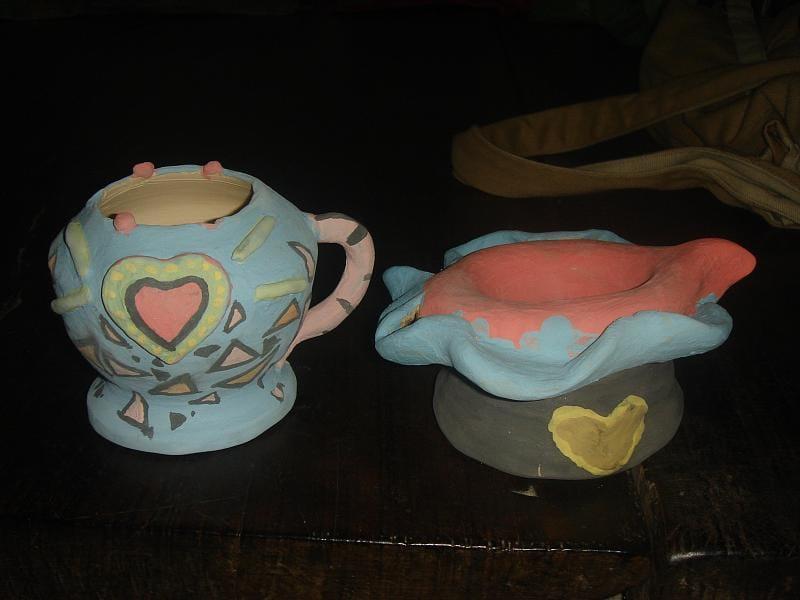
Removed from Unnamed collection
Bat Trang 
Bat Trang, traditional porcelain and pottery village with a history of seven centuries is an interesting attraction in Hanoi that tourists should not ignore. Bat Trang, the seven-century old pottery village, is an interesting attraction in Hanoi that tourists should not ignore.
Bat Trang ceramics are produced for daily household use (bow, cup, plates, pot, bottle…), worshipping, or decoration purposes. Nowadays, the pottery artists bring into ceramics many innovations in production techniques, and creativity in products’ features, hence many new products have been born, and even daily household items may have the beauty like decoration ones.
Visiting Bat Trang, tourists can take a walk or join a buffalo tour for sightseeing and shopping. Besides many ceramic stores along the road in the village, tourists should visit Bat Trang Porcelain and Pottery Market where they can directly make pottery products by themselves. Many youngsters and foreign tourists are interested in in this pottery- making experience, and spend a whole day in the market to make a gift for family or friends. https://www.vietnamonline.com/attraction/bat-trang-porcelain-and-pottery-village.html
Map
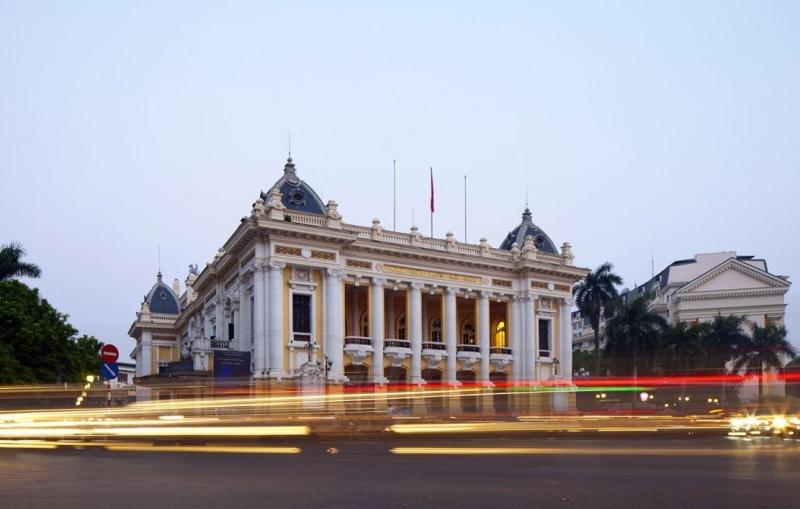
Removed from Unnamed collection
Hanoi Opera House 
The beautiful Hanoi Opera House was built in 1911 by the then ruling French. It’s a phenomenal piece of neo-classical French architecture featuring Gothic themes on the doors and domes with pillars, shuttered windows, balconies and a glass room. Musicians, actors and dancers play to a 600-strong audience delivering powerful operatic and classical performances, making it a very popular theatrical attraction.
The Hanoi Opera House is the biggest theatre in Vietnam and speaks volumes as historical and cultural evidence of Vietnam under French rule. The interior is even more magnificent than the exterior with many arguing it is aesthetically even more appealing than the Paris Opera House. Visitors today will be entertained at this architectural landmark which features a range of events including local Vietnamese opera, traditional folk music, ballets and many international concerts. http://www.vietnam-guide.com/hanoi/hanoi-opera-house.htm
Map
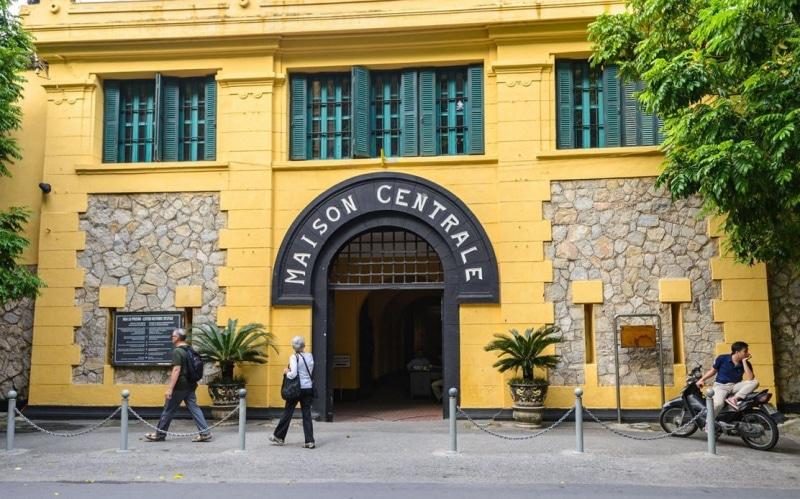
Removed from Unnamed collection
Maison Centrale 
Maison Centrale in Hanoi, also known as Hoa Lo Prison and the ‘Hanoi Hilton’ housed Vietnamese revolutionaries and American POW during the Vietnam War. The fortress was once a vast colonial-style prison, most of which was torn down in the 1990s.
Visiting today you will find the small southern section resting alongside a hotel and office complex.
The prison is still a popular tourist attraction for those on the war history trail. Official records claim inmates numbered in their hundreds although it was not unknown for up to 2,000 prisoners to be crammed into a space reserved for 600 inmates. Around 200-300 inmates were captured American pilots brought to Maison Centrale for interrogation and torture, it was the American prisoners who sarcastically gave the jail its nickname ‘Hanoi Hilton’.
Hoa Lo Prison today portrays a different side of the horror stories told by former inmates despite the prominently displayed shackles hanging on the walls. Much of the emphasis is on the Vietnamese revolutionaries some of whom were executed at the prison. The American POWs have well documented their own experiences, little of which is available at Maison Centrale today. http://www.vietnam-guide.com/hanoi/hanoi-maison-centrale.htm
Map
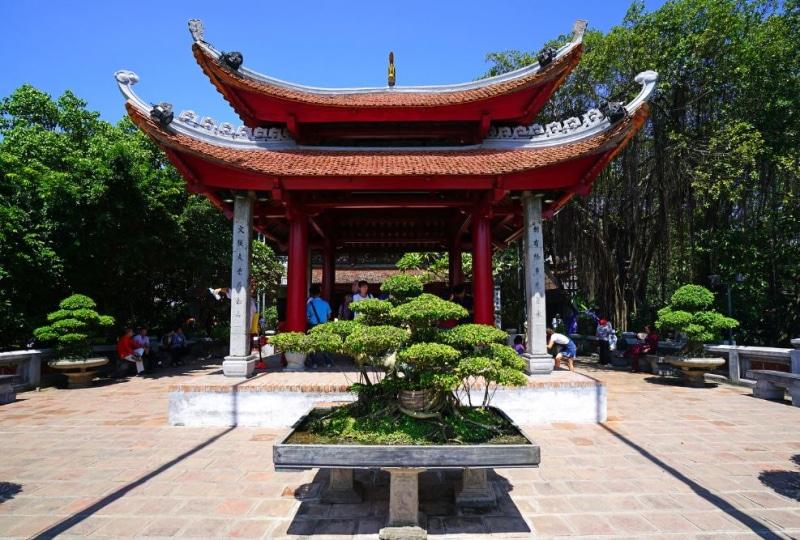
Removed from Unnamed collection
Ngoc Son Temple 
Ngoc Son Temple was built in the 18th century on Jade Island in the centre of the ‘Lake of the Returned Sword’ or Hoan Kiem Lake. Legend describes how an emperor was once given a magical sword which helped him defeat the Chinese Ming Dynasty and in doing so saw the return of the Golden Turtle God to the lake.
Today ‘Turtle Tower’ stands close to the lake in memory of this legend. There are also endangered large soft-shell turtles swimming in the lake, and to see one of these gentle giants is considered very auspicious. The name of the temple translates to ‘Temple of the Jade Mountain’ and is predominately dedicated to war hero General Tran Hung Dao who defeated an armed force of 300,000 soldiers sent by Mongolian Emperor Kublai Khan in the 13th century to invade Vietnam.
Also inside the pagoda are a large bronze bust and other deities. There are altars dedicated to Tran Hung Dao, some ancient artefacts including ceramics and a preserved specimen of a giant turtle found in the lake weighing 250kg. http://www.vietnam-guide.com/hanoi/hoan-kiem-lake.htm
Map
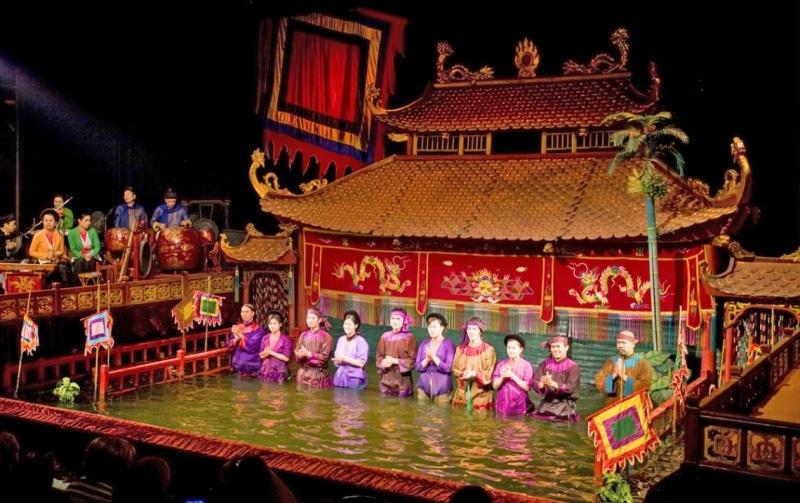
Removed from Unnamed collection
Water Puppet Theatre 
The world-famous Thang Long Water Puppet Theatre in Hanoi has its roots in an art form that dates back to the 11th century. The tradition of water puppet theatre stems from a time when rice paddy fields were flooded and villagers would make entertainment by standing in the waist-deep water with the puppets performing over the water.
Using large rods to support the puppets it appeared as if they were moving across the water with the puppeteers hidden behind a screen.
This tradition is unique to North Vietnam but has recently found fame on stages all over the world; so it’s a rare treat to see the puppets perform in their original location at the Thang Long Water Puppet Theatre. Performances are accompanied by a Vietnamese orchestra playing traditional music using drums, wooden bells, horns, bamboo flutes and cymbals. There are also authentic Vietnamese operatic songs telling the story that is being acted out by the puppets. Most of the shows recount Vietnamese folk tales and legends with topics including the celebration of the rice harvest depicted in a humorous fashion. http://www.vietnam-guide.com/hanoi/water-puppet-theatre.htm
Map
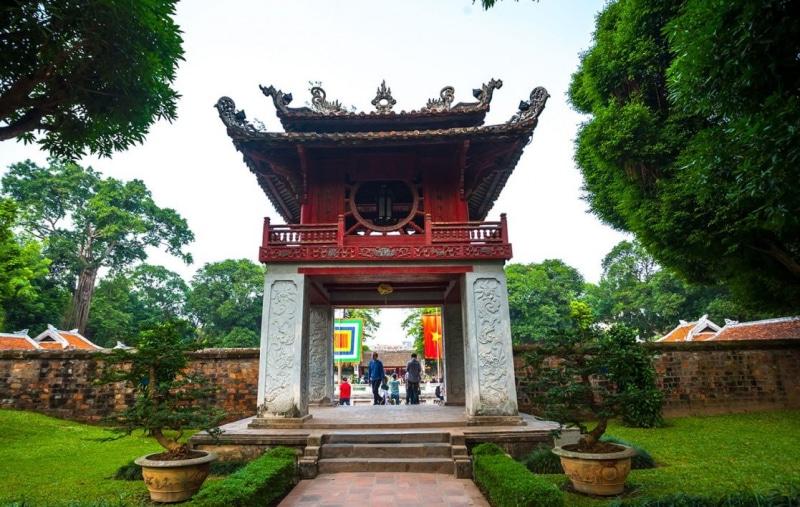
Removed from Unnamed collection
Temple Of Literature 
The Temple of Literature is often cited as one of Hanoi’s most picturesque tourist attractions. Originally built as a university in 1070 dedicated to Confucius, scholars and sages, the building is extremely well preserved and is a superb example of traditional-style Vietnamese architecture.
This ancient site offers a lake of literature, the Well of Heavenly Clarity, turtle steles, pavilions, courtyards and passageways that were once used by royalty. Visiting the Temple of Literature you will discover historic buildings from the Ly and Tran dynasties in a revered place that has seen thousands of doctors’ graduate in what has now become a memorial to education and literature.
Originally the university only accepted aristocrats, the elite and royal family members as students before eventually opening its doors to brighter ‘commoners’. Successful graduates had their names engraved on a stone stele which can be found on top of the stone turtles. http://www.vietnam-guide.com/hanoi/temple-of-literature.htm
Map
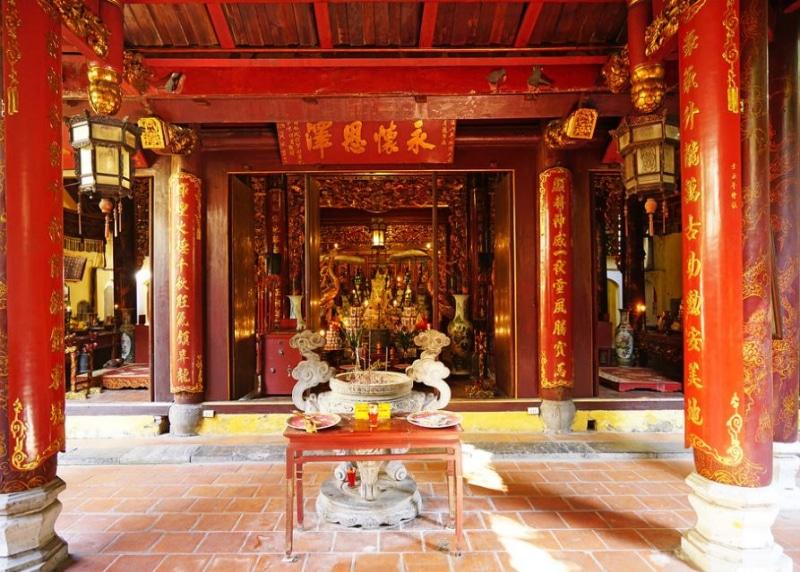
Removed from Unnamed collection
Bach Ma Temple 
Bach Ma Temple is believed to be the oldest temple in Hanoi. This Buddhist temple was originally built in the ninth century by King Ly Thai To in honour of Bach Ma. According to a sign inside the temple, originally the site of the temple was Long Do Mountain. The temple was moved to its current location in the Old Quarter of Hanoi in the 18th century, during the Ly Dynasty, to guard the east side of Thang Long.
The translation of Bach Ma is ́White Horse ́ and this refers to a story behind the construction of the Temple. King Ly Thai To had been struggling to build the temple as its walls kept collapsing. It is said that a white horse delineated the best area to build the temple with its hooves to help the king in constructing the temple. http://www.vietnam-guide.com/hanoi/attractions/bach-ma-temple.htm
Map

Removed from Unnamed collection
Imperial Citadel of Thang Long 
The Imperial Citadel of Thang Long, is an intriguing relic of Vietnam’s history and, signifying its historical and cultural importance, was made a UNESCO World Heritage Site in 2010. Also known as the Hanoi Citadel, many artefacts and items dating back to between the 6th and 20th centuries were excavated in 2004, including foundations of old palaces, ancient roads, ponds and wells.
On top of these discoveries, archaeologists also found bronze coins, ceramics and pottery from China and many places in Asia, all of which demonstrate a close trading relationship in the area. Visitors should head for the display room that features interesting excavated items and mock-ups of the citadel itself. http://www.vietnam-guide.com/hanoi/imperial-citadel.htm
Map
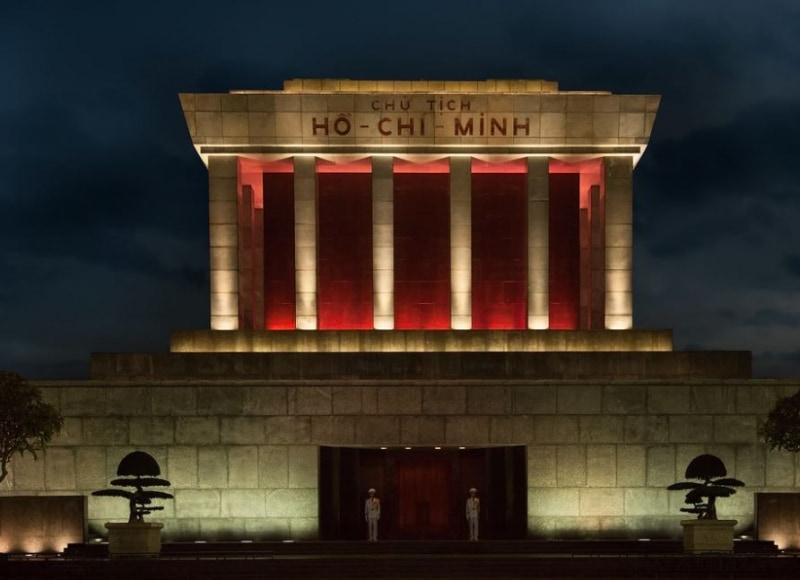
Removed from Unnamed collection
Ho Chi Minh Mausoleum 
Ho Chi Minh Mausoleum in Ba Dinh Square is one of the most visited attractions in Hanoi. It is the final resting place of Ho Chi Minh, the most iconic and popular leader of Vietnam, known to his people as ‘Uncle Ho’. His body is preserved here in a glass case at the Ho Chi Minh Mausoleum in central Hanoi (albeit against his wishes).
For visitors, a trip to Uncle Ho’s final resting place can be an extraordinary experience as it is not just an average attraction; it’s a part of a unique history.
Started in 1973, the construction of the mausoleum was modelled on Lenin's mausoleum in Russia and was first open to the public in 1975. The granite building meant a great deal for many locals as it ensures that their beloved leader ‘lives on forever’.
Security is tight and visitors should dress with respect (no shorts, sleeveless shirts and miniskirts) and everyone has to deposit their bags and cameras before getting in. Visitors are not allowed to stop and hold the constant queue up as the place is constantly busy. Uncle Ho’s remains are sent yearly to Russia for maintenance therefore the mausoleum is closed usually from October onwards. It’s best to recheck with your hotel tour desk before visiting. Admission is free but donations are accepted. http://www.vietnam-guide.com/hanoi/hochiminh-mausoleum.htm
Map

Removed from Unnamed collection
Banteay Srei 
The tenth century temple of Banteay Srei is renowned for its intricate decoration carved in pinkish sandstone that covers the walls like tapestry.
Banteay Srei is an exquisite miniature; a fairy palace in the heart of an immense and mysterious forest; the very thing that Grimm delighted to imagine, and that every child's heart has yearned after, but which mature years has sadly proved too lovely to be true. And here it is, in the Cambodian forest at Banteay Srei, carved not out of the stuff that dreams are made of, but of solid sandstone. https://www.tourismcambodia.com/attractions/angkor/banteay-srei.htm
Map
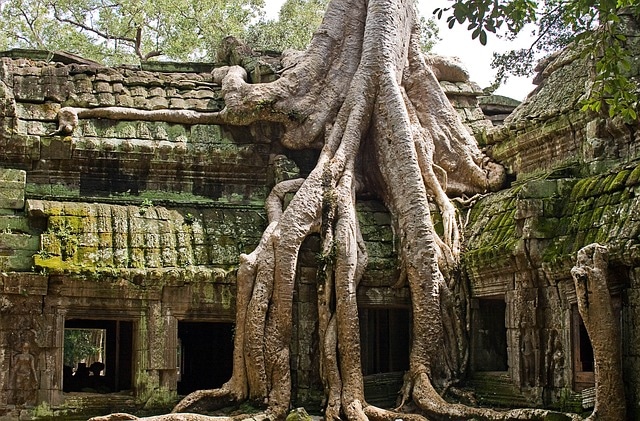
Removed from Unnamed collection
Ta Prohm Temple 
Shrouded in dense jungle the temple of Ta Prohm is ethereal in aspect and conjures up a romantic aura. Fig, banyan and kapok trees spread their gigantic roots over stones, probing walls and terraces apart, as their branches and leaves intertwine to form a roof over the structures. Trunks of trees twist amongst stone pillars. The strange, haunted charm of the place entwines itself about you as you go, as inescapably as the roots have wound themselves about the walls and towers', wrote a visitor 40 years ago.
Ta Prohm is among the largest of the monuments in the Angkor complex, the inscription gives an idea of the size of the temple. The complex included 260 statues of gods, 39 towers with pinnacles and 566 groups of residences. Ta Prohm comprises a series of long low buildings standing on one level, which are enclosed by rectangular laterite wall (600 by 1,000 meters, 1,959 by 3,281 feet). Only traces of the wall are still visible. The center of the monument is reached by a series of towers connected with passages. This arrangement forms a ' sort of sacred way into the heart of the monument’; three-square galleries enclose the area. https://www.tourismcambodia.com/attractions/angkor/ta-prohm.htm
Map
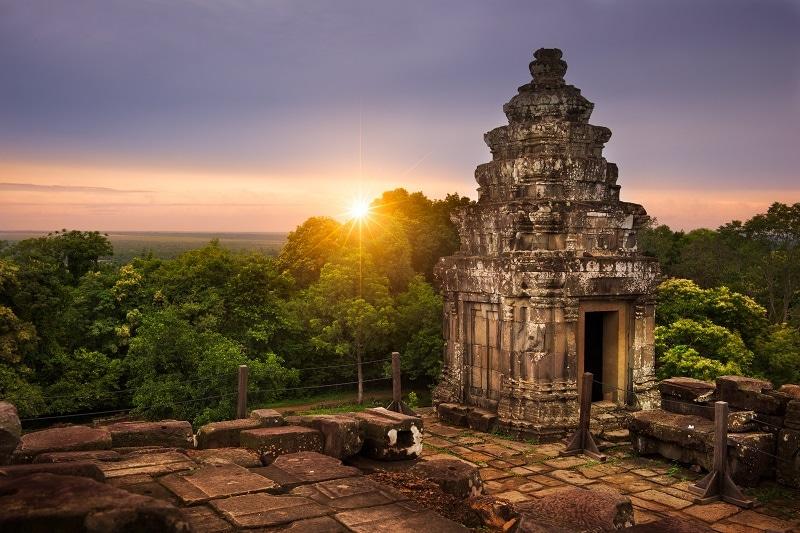
Removed from Unnamed collection
Phnom Bakheng Hill 
It is a testimony to the love of symmetry and balance which evolved its style....in pure simplicity of rectangles its beauty is achieved. It is a pyramid mounting in terraces, five of them ...Below Bak-Keng lays all the world of mystery, the world of the Khmer, more mysterious ever under its cover of impenetrable verdure.
Phnom Bakheng is located 1,30 meters (4,265 feet) north of Angkor Wat and 400 meters (1,312 feet) south of Angkor Thom.
Enter and leave Phnom Bakheng by climbing a long steep path with some steps on the east side of the monument (height 67 meters, 220 feet) In the 1960 this summit was approached by elephant and, according to a French visitor, the ascent was "a promenade classic and very agreeable.
Arrive at the summit just before sunset for a panoramic view of Angkor and its environs. The golden hues of the setting sun on this vista are a memorable sight. https://www.tourismcambodia.com/attractions/angkor/bakheng-mountain.htm
Map

Removed from Unnamed collection
Angkor Wat 
There are few places anywhere on earth to match the splendour of Angkor Wat. The temple is one of the largest monuments to religion ever built and is truly one the wonders of the world. Believed to have been constructed as a temple and mausoleum for King Suryavarman II at the peak of the Khmer empire in the first half of the 12th century, Angkor Wat is probably the best-preserved of the Angkorean temples. As with other Angkorean temples and walled cities such as Angkor Thom, the central theme of Khmer architecture revolved around the idea of the temple-mountain. https://www.tourismcambodia.com/travelguides/provinces/siem-reap/what-to-see/294_angkor-wat.htm
Map

Removed from Unnamed collection
Angkor Thom 
Angkor Thom is undeniably an expression of the highest genius. It is, in three dimensions and on a scale worthy of an entire nation, the materialization of Buddhist cosmology, representing ideas that only great painters would dare to portray.
Angkor Thom, the last capital of the Khmer Empire, was a fortified cit enclosing residences of priest, officials of the palace and military, as well as buildings for administering the kingdom. These structures were built of wood and have perished but the remaining stone monuments testify that Angkor Thom was indeed a "Great City" as its name implies. Temples inside the walls of the city described are Bayon, Phimeanakas, Baphuon, Terrace of the Elephants, Terrace of the Leper King, Prah Palilay, Tep Pranam and Prasat Suor Prat.
Symbolically, Angkor Thom is a microcosm of the universe, divided into four parts by the main axes. The temple of the Bayon is situated at the exact center of the axes and stands as the symbolical link between heaven and earth. The wall enclosing the city of Angkor Thom represents the stonewall around the universe and the mountain ranges around Meru. The surrounding moat (now dry) symbolizes the cosmic ocean. https://www.tourismcambodia.com/attractions/angkor/angkor-thom.htm
Map
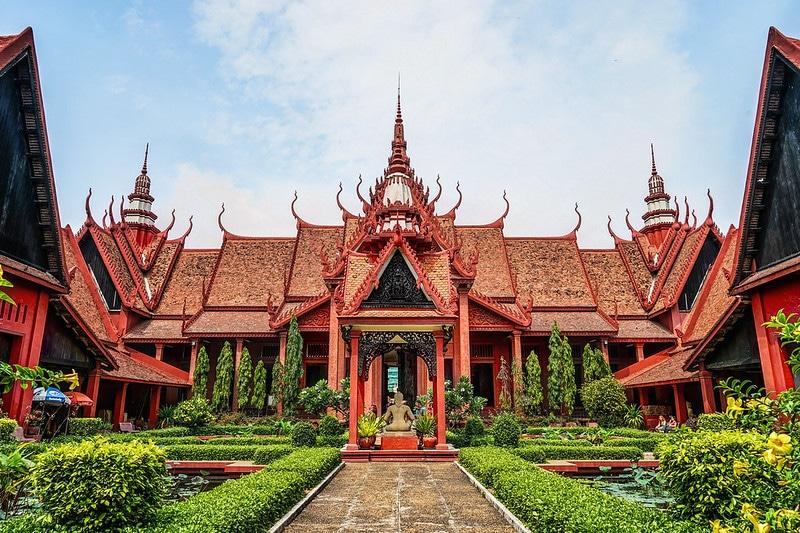
Removed from Unnamed collection
National Museum of Cambodia 
The National Museum of Cambodia houses one of the world's greatest collections of Khmer cultural material including sculpture, ceramics and ethnographic objects from the prehistoric, pre-Angkorian, Angkorian and post-Angkorian periods.
The main activities of the National Museum of Cambodia include exhibiting, safeguarding and promoting understanding of Cambodia’s cultural and artistic treasures. Keeping objects safe and working to ensure the repatriation of pieces stolen from Cambodia are important aspects of the museum’s work, particularly as looting and illicit export of cultural material are a continuing concern. In addition, the Museum strives to engage its visitors through its exhibitions and to fulfil its role as an integral part of the community. The Museum believes that Cambodia’s cultural heritage is of great value and can provide a source of pride and identity to the Cambodian people who have lost so much in recent decades. The availability of multilingual Museum tour guides and Publications, as well as the Museum’s public library, all serve to increase the accessibility of the collection both for local and international visitors. http://www.cambodiamuseum.info/museum_history.html
Map
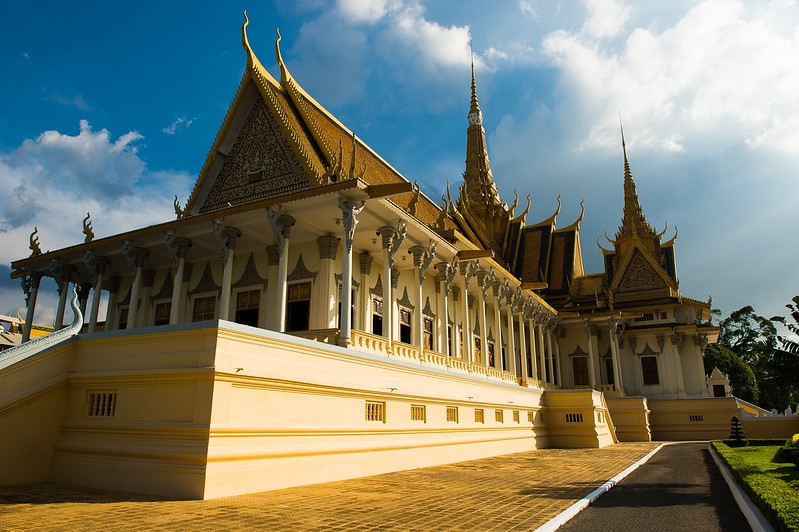
Removed from Unnamed collection
Royal Palace of Cambodia 
Cambodia’s Royal Palace complex was begun by King Norodom I (ruled 1860-1904) in 1886, when the capital was moved to Phnom Penh. Most buildings were completed before World War I, with involvement by French administrators and Thai designers and architects. French influence can be seen in the formal gardens which enhance the palace, and there are some European-style buildings on the grounds. Now Royal Palace is a home to His Majesty Preah Bat Samdech Preah Sihamoni, King of Cambodia.
Royal palace has four gates. The eastern Victory Gate leads directly to the entrance of the throne hall and is used only by royalty and VIPs. The northern or funeral gate is only opened after the death of a monarch. After being embalmed, the monarch’s body is kept in state at the palace for three months, with the face hidden by a one-kilogram solid gold mask, before being taken out via this gate. The west or executing gate was used by condemned prisoners exiting the palace to be killed. The southern gate is reserved for use by commoners and it is through this gate the public reaches the Silver Pagoda.
At the top of palace’s throne hall, note the four pale, almost clown-like faces, which represent the all-seeing king. The hall itself is painted vivid yellow, a symbol of Buddhism, and white, for Hinduism, the two main faiths of Cambodia until they were combined into one by Jayavarman VII in the 12th century. The central door of the five at the front of the throne hall are reserved for royalty and VIPs. Inside, note the 1913 ceiling mural telling the story of the Ramayana. The thick carpet supplied by China in 1993 matches the lotus-bud floor tiles. http://www.yourphnompenh.com/royal-palace-and-silver-pagoda/
Map
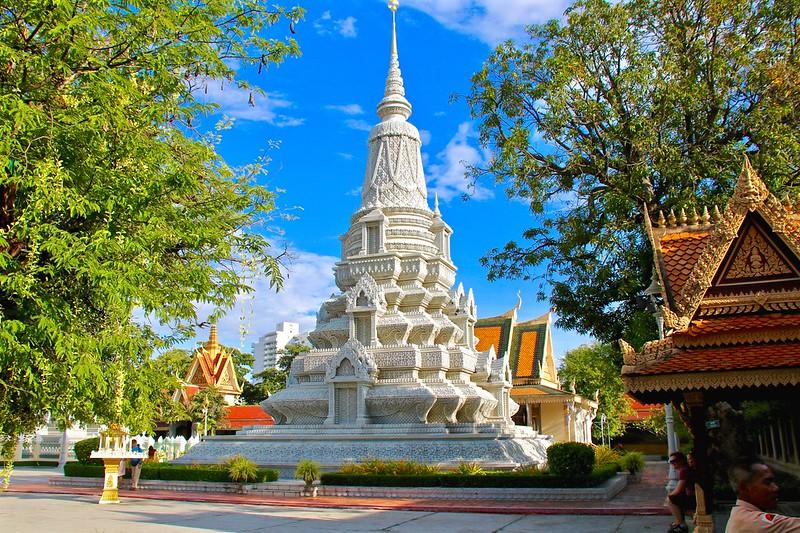
Removed from Unnamed collection
Silver Pagoda 
Wat Preah Keo Morakot (Silver Pagoda) is located in the southern portion of the Royal Palace complex. The pagoda was formerly known as Wat Uborsoth Rotannaram because it is where the King worshiped, prayed and practiced every Buddhist Silas Day. In the additional, the royal family and officials also held Buddhist ceremonies there.This pagoda has no monks. However, this Majestic King Norodom Sihanouk lived there for one year when he entered the monkhood on July 31, 1947. Because the pagoda has no monks, visitors usually refer to it as Preah Vihear Preah Keo Morakot. When the King celebrates Buddhist ceremonies, monks from other pagoda such as Wat Unaloam and Wat Botumvattey are invited to attend the ceremonies. Preah Vihear Preah Keo Morakot was built between 1892 and 1902, during the reign of King Norodom, but at that time it was constructed of wood and brick. Its design is base on Cambodian architectural style. Then Banhchos Khan Seima ceremony was held on Feb 5, 1903.
There are 1,650 art objects housed in this temple. Most of them are Buddha figures. They are made of gold, silver, bronze and other valuable materials. Some are decorated with diamonds. They are gifts from the King, the royal family, dignitaries and other people who worship at Preah Vihear Preah Keo Morakot, where they pray for peace and prosperity, for happiness and for the preservation of Cambodian cultural heritage for the next generation. In front of the throne, site a Buddha statue made of gold, weighing 90 kilograms (about 200 pounds) and decorated with 2,086 diamonds. The biggest diamond is on the crown. It is 25 millimeters. This statue was commissioned in 1904 by King Sisowath, following the suggestion of King Norodom. King Norodom said, after his body was cremated the gold casket should be melted to make Buddha statue representing Preah Srei Araymetrey. This Buddha statue is named Preah Chin Raingsei Rachik Norodom. https://www.tourismcambodia.com/travelguides/provinces/phnom-penh/what-to-see/370_silver-pagoda.htm
Map

Removed from Unnamed collection
Chu Chi Tunnels 
The Chu Chi Tunnels are part of a massive war museum in Ho Chi Minh. They offer visitors a sneak-peek at the underground life of Vietnamese soldiers back in 1948. The site has over 120km of underground tunnels, with trapdoors, living areas, kitchens, storage facilities, armoury, hospitals, and command centres. After the war against the French, Vietnamese soldiers expanded the tunnels and included effective air filtration systems, which helped them survive the Chu Chi carpet-bombings.
It is now one of Ho Chi Minh’s most iconic attractions. You can enjoy plenty of activities during your visit. A popular option is following the narrow routes of the underground tunnel. Before entering the underground tunnels, visitors watch a short film of Chu Chi Tunnels so that they understand how the tunnel system works. Parts of Chu Chi Tunnels are also cemented and widened so that the crawl is less harrowing than it would have been in the past. http://www.vietnam-guide.com/ho-chi-minh-city/cu-chi-tunnels.htm
Map

Removed from Unnamed collection
Phra Nakhon Si Ayutthaya 
The charm of ancient city of Ayutthaya Thailand continues to gain tourists’ attention as a historic attraction. Not only the old moments but also the new things that shine.
When it comes to historical buildings, Ayutthaya travel is well known for temples and palaces. But in addition to that, a variety of food is also another magnet. You can find fresh river prawns, fish, noodles, and even the never-miss dessert like cotton candy wrap. So, remember to plan your eating trip whenever you visit Ayutthaya.
Ayutthaya is one of Thailand’s historical and majestic highlights. The capital of Thailand, then known as the Kingdom of Ayutthaya, Phra Nakhon Si Ayutthaya was a glorified as one of the biggest cities in Southeast Asia and a regional power for 417 years. https://au.tourismthailand.org/About-Thailand/Destination/Ayutthaya
Map
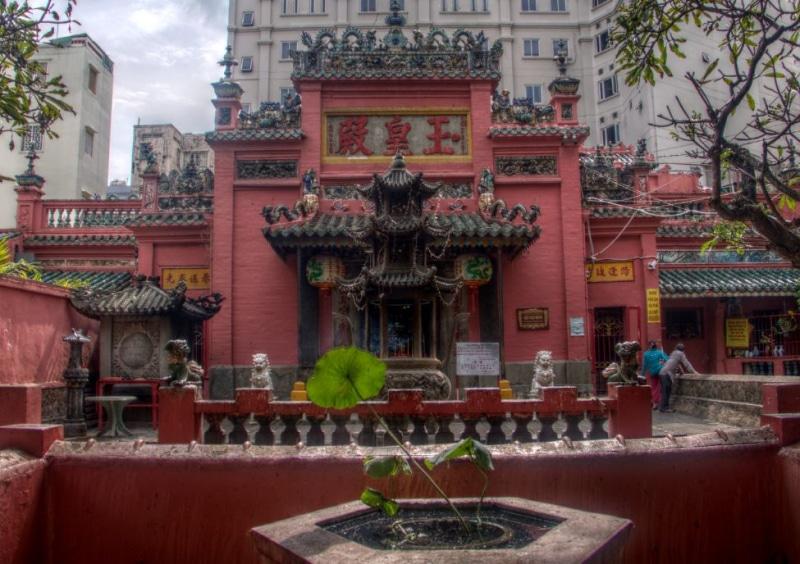
Removed from Unnamed collection
Jade Emperor Pagoda 
Emperor Jade Pagoda, also known as Tortoise Pagoda, is one of the five most important shrines in Ho Chi Minh City.
Built at the turn of the 20th Century by a community of Cantonese who migrated from Guangzhou province in Southwest China, this pagoda is a fine representation of Mahayanist branch of Buddhism that is practised widely in Vietnam.
In the main hall, the Emperor Jade Chua Ngoc Hoang or the 'God of the Heavens' reigns supreme. Aided by two assistants, the Emperor decides who can enter this higher realm. Those who don't pass this gate will meet with the formidable 'God of Hell', on the left, who will send sinners to one of the 10 levels of hell. Life in purgatory is magnificent if somewhat gruesomely represented by the intricate carvings on the temple wall, depicting different kinds of punishments that await transgressors.
In a different hall, the goddess of fertility Kim Hua, surrounded by figures of women and small children, blesses childless couples who pray for an offspring here. The goddess of mercy Kuan Yin, who forms a very important part of any Taoist temple, has an altar in a room on the top floor.
Emperor Jade Pagoda is a living and working shrine very much in use by the locals who come here to prayer or make votive offerings of flowers and light candles and joss sticks. With worshippers coming and going, the temple can get busy and feel a little cramped. Its dimly lit, the narrow passageways filled with smoke lend an atmospheric feel to the place, adding to its charm. http://www.vietnam-guide.com/ho-chi-minh-city/jade-emperor-pagoda.htm
Map

Removed from Unnamed collection
Galerie Quynh 
Spending time with Quynh Pham, founder and director of Galerie Quynh, is always a delightful experience, and highly recommended as a starting point for one’s expedition into Saigon’s dynamic art scene. Her eyes alight with passion during one-on-one tours. For more than a decade, Galerie Quynh has been Saigon’s leading art space, championing the country’s most established and emerging artists. http://vietnamtourism.vn/things-to-do/contemporary-art-scene-ho-chi-minh-city
Map

Removed from Unnamed collection
Sukhumvit Road in Bangkok 
Bangkok’s Sukhumvit Road and the surrounding district is one of the best known localities in the Thai capital. Unlike some districts in the city you won’t find beautiful temples or palaces here; Sukhumvit Bangkok is better known for its Westernised feel and consists of bars, restaurants and shopping malls that you’ll find alongside sois that are filled with even more bars (salubrious and otherwise) and massage parlours. The sex trade is difficult to ignore with prostitutes almost everywhere you look, and you wouldn’t come to Sukhumvit Road for the traditional Thai culture, but even so, it’s one of the most visited neighbourhoods in the city. So why the interest? Read on to discover our recommendations for amazing places to visit on Sukhumvit Road in Bangkok. https://bangkokattractions.com/sukhumvit-road-bangkok/
Map
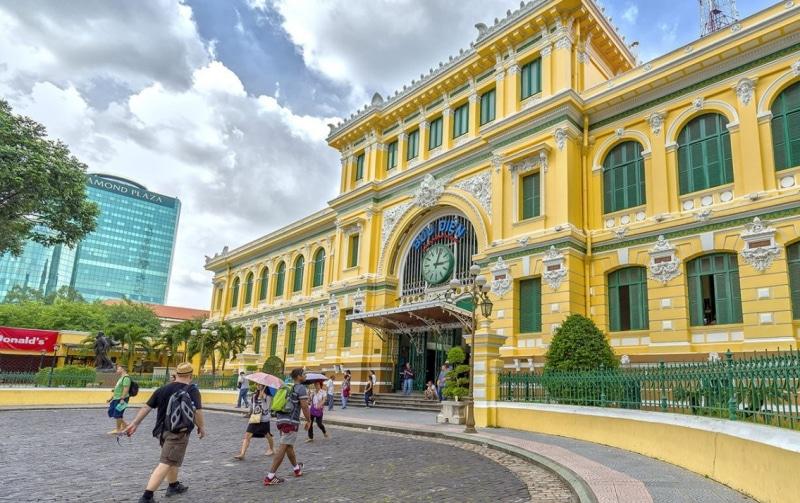
Removed from Unnamed collection
Saigon Central Post Office 
The Central Post Office in Ho Chi Minh is a beautifully preserved remnant of French colonial times and perhaps the grandest post office in all of Southeast Asia. Located next door to Notre Dame Cathedral, the two cultural sites can be visited together and offers visitors a chance to imagine life in Vietnam during the times of the Indochinese Empire. The building was designed by Alfred Foulhoux and features arched windows and wooden shutters, just as it would have in its heyday in the late 19th Century.
The Central Post Office in Ho Chi Minh was constructed between 1886 and 1891 and once inside, the looping arches, intricately designed marble floors and antiquated telephone boxes all serve as a reminder of the importance the post office played in days before email and mobile phones. Although the architecture is distinctly French, the large portrait of Ho Chi Minh hanging high above everyone at the far end of the building reminds everyone we are definitely in Vietnam. Painted onto walls overhead are two maps of the region; one of them showing the telegraph lines that crisscross Vietnam and Cambodia and the other displaying a map of the Saigon region in 1892.
Although the experience is a fascinating glimpse into history, the fact that this is still a functioning post office makes the experience even sweeter, and we encourage everyone to send a letter or postcard from here – it’s a piece of living history where even the old fashioned glue pots are still in use for sticking stamps to letters. There are two wings branching out from the main office, selling souvenirs, postcards and lacquerware but the prices are inflated and the same products can probably be found elsewhere for a better price. http://www.vietnam-guide.com/post-office-ho-chi-minh.htm
Map

Removed from Unnamed collection
Notre Dame Cathedral of Saigon 
Saigon Notre Dame Cathedral, built in the late 1880s by French colonists, is one of the few remaining strongholds of Catholicism in the largely Buddhist Vietnam. Located in Paris Square, the name Notre Dame was given after the installation of the statue ‘Peaceful Notre Dame’ in 1959.
In 1962, the Vatican conferred the Cathedral status as a basilica and gave it the official name of Saigon Notre-Dame Cathedral Basilica. Measuring almost 60 metres in height, the cathedral’s distinctive neo-Romanesque features include the all-red brick façade (which were imported from Marseille), stained glass windows, two bell towers containing six bronze bells that still ring to this day, and a peaceful garden setting in the middle of downtown Ho Chi Minh City District 1. http://www.vietnam-guide.com/ho-chi-minh-city/notre-dame-cathedral.htm
Map



